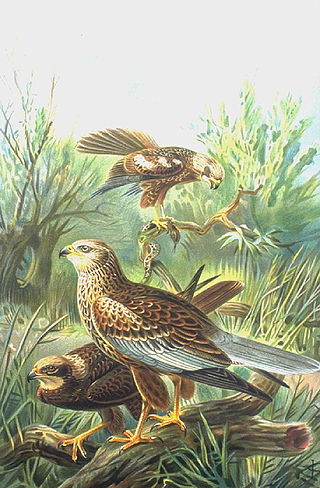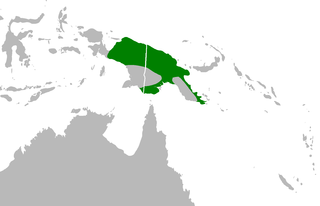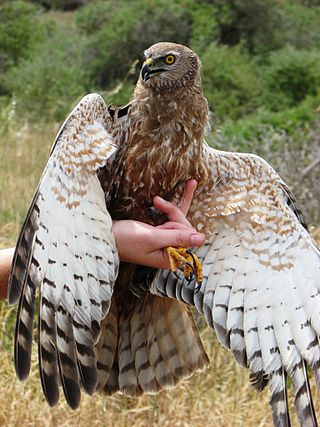
The desert wheatear is a wheatear, a small passerine bird that was formerly classed as a member of the thrush family Turdidae, but is now more generally considered to be an Old World flycatcher (Muscicapidae). It is a migratory insectivorous species, 14.5 to 15 cm in length. Both western and eastern forms of the desert wheatear are rare vagrants to western Europe. The western desert wheatear breeds in the Sahara and the northern Arabian peninsula. The eastern race is found in the semi-deserts of Central Asia and in winter in Pakistan and northeast Africa.

The hen harrier is a bird of prey. It breeds in Eurasia. The term "hen harrier" refers to its former habit of preying on free-ranging fowl.

Montagu's harrier (Circus pygargus) is a migratory bird of prey of the harrier family. Its common name commemorates the British naturalist George Montagu.

The Pallid Harrier is a migratory bird of prey of the harrier subfamily. The scientific name is derived from the Ancient Greek. Circus is from kirkos (circle), referring to a bird of prey named for its circling flight, and macrourus is "long-tailed", from makros (long) and -ouros (-tailed).

The marsh harriers are birds of prey of the harrier subfamily. They are medium-sized raptors and the largest and broadest-winged harriers. Most of them are associated with marshland and dense reedbeds. They are found almost worldwide, excluding only the Americas.

The western marsh harrier is a large harrier, a bird of prey from temperate and subtropical western Eurasia and adjacent Africa. It is also known as the Eurasian marsh harrier. Formerly, a number of relatives were included in C. aeruginosus, which was then known as "marsh harrier". The related taxa are now generally considered to be separate species: the eastern marsh harrier, the Papuan harrier of eastern Asia and the Wallacea, the swamp harrier of Australasia and the Madagascar marsh harrier of the western Indian Ocean islands.

The red-rumped swallow is a small passerine bird in the swallow family. It breeds in open hilly country of temperate southern Europe and Asia from Portugal and Spain to Japan, India, Sri Lanka and tropical Africa. The Indian and African birds are resident, but European and other Asian birds are migratory. They winter in Africa or India and are vagrants to Christmas Island and northern Australia.

The whiskered tern is a tern in the family Laridae. The genus name is from Ancient Greek khelidonios, "swallow-like", from khelidon, "swallow". The specific hybridus is Latin for hybrid; Peter Simon Pallas thought it might be a hybrid of white-winged black tern and common tern, writing "Sterna fissipes [Chlidonias leucopterus] et Hirundine [Sterna hirundo] natam".

The masked shrike is a species of bird in the shrike family, Laniidae. It breeds in southeastern Europe and at the eastern end of the Mediterranean, with a separate population in eastern Iraq and western Iran. It is migratory, wintering mainly in northeast Africa. Although it is a short-range migrant, vagrants have occurred widely elsewhere, including northern and western Europe. It is the smallest member of its genus, long-tailed and with a hooked bill. The male has mainly black upperparts, with white on its crown, forehead and supercilium and large white patches on the shoulders and wings. The throat, neck sides and underparts are white, with orange flanks and breast. The female is a duller version of the male, with brownish black upperparts and a grey or buff tone to the shoulders and underparts. The juvenile has grey-brown upperparts with a paler forehead and barring from the head to rump, barred off-white underparts and brown wings аpart from the white primary patches. The species' calls are short and grating, but the song has melodic warbler-like components.

The tiger shrike or thick-billed shrike is a small passerine bird which belongs to the genus Lanius in the shrike family, Laniidae. It is found in wooded habitats across eastern Asia. It is a shy, often solitary bird which is less conspicuous than most other shrikes. Like other shrikes it is predatory, feeding on small animals. Its nest is built in a tree and three to six eggs are laid.

The cinereous harrier is a South American bird of prey of the harrier family. Its breeding range extends from the Tierra del Fuego through Argentina and Chile to Bolivia, Paraguay, Peru and southern Brazil; and across the Andes north to Colombia. The bird's population is declining but due to its large range is not considered vulnerable. The term cinereous, deriving from the Latin word for ashy, describes its colouration.

The spotted harrier also known as the smoke hawk, is a large Australasian bird of prey belonging to the family Accipitridae.

The Papuan harrier is a bird of prey native to New Guinea which belongs to the harrier genus Circus. It was classified as a subspecies of the eastern marsh harrier of eastern Asia.

The Malagasy harrier is a bird of prey belonging to the marsh harrier group of harriers. It inhabits Madagascar and the Comoro Islands in the Indian Ocean. It was formerly regarded as a subspecies of the Réunion harrier but is increasingly treated as a separate species. It is also known as the Madagascar harrier, Madagascar marsh harrier or Malagasy marsh harrier.

The Réunion harrier, also known as Réunion marsh harrier, is a species of bird of prey belonging to the marsh harrier group of harriers. It is now found only on the Indian Ocean island of Réunion, although fossil material from Mauritius has been referred to this species. It is known locally as the papangue or pied jaune. The Malagasy harrier of Madagascar and the Comoro Islands was previously treated as a subspecies of this bird but is increasingly regarded as a separate species. The Réunion harrier appears to be declining in numbers and it is classed as an endangered species.

The African marsh harrier is a bird of prey belonging to the harrier genus Circus. It is largely resident in wetland habitats in southern, central and eastern Africa from South Africa north to South Sudan.

The Asian house martin is a migratory passerine bird of the swallow family Hirundinidae. It has mainly blue-black upperparts, other than its white rump, and has pale grey underparts. Its three subspecies breed in the Himalayas and in central and eastern Asia, and spend the winter lower in the mountains or in Southeast Asia. This species is locally abundant and is expanding northward in Siberia, so there are no concerns about its conservation status.

Eversmann's redstart, also known as the rufous-backed redstart, is a passerine bird belonging to the genus Phoenicurus. It was formerly classified in the thrush family Turdidae but is now placed in the Old World flycatcher family Muscicapidae. It was described by the German biologist Eduard Friedrich Eversmann who is commemorated in the bird's English name.

The Oriental reed warbler is a passerine bird of eastern Asia belonging to the reed warbler genus Acrocephalus. It was formerly classified as a subspecies of the great reed warbler of the western Palearctic.

The Oriental cuckoo or Horsfields cuckoo is a bird belonging to the genus Cuculus in the cuckoo family Cuculidae. It was formerly classified as a subspecies of the Himalayan cuckoo, with the name 'Oriental cuckoo' used for the combined species. Differences in voice and size suggest that it should be treated as a separate species. The binomial name Cuculus horsfieldi has often been used instead of Cuculus optatus, but is now usually considered to be a junior synonym.





















